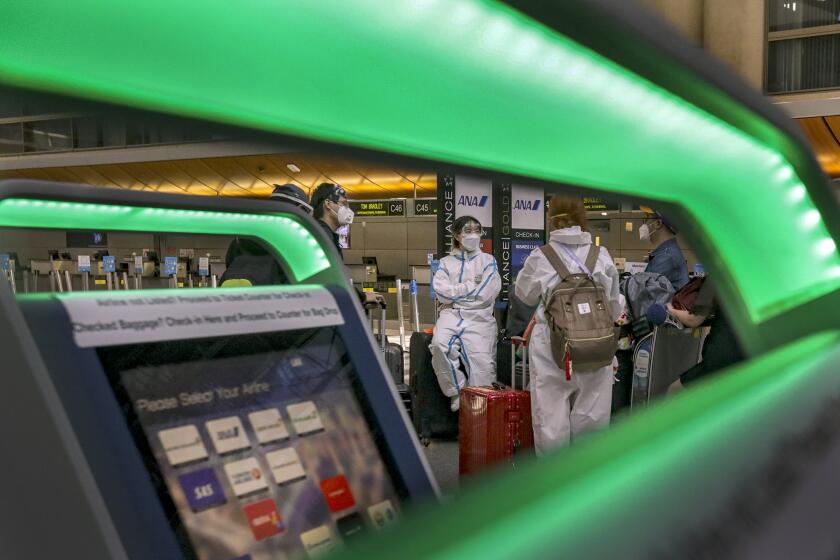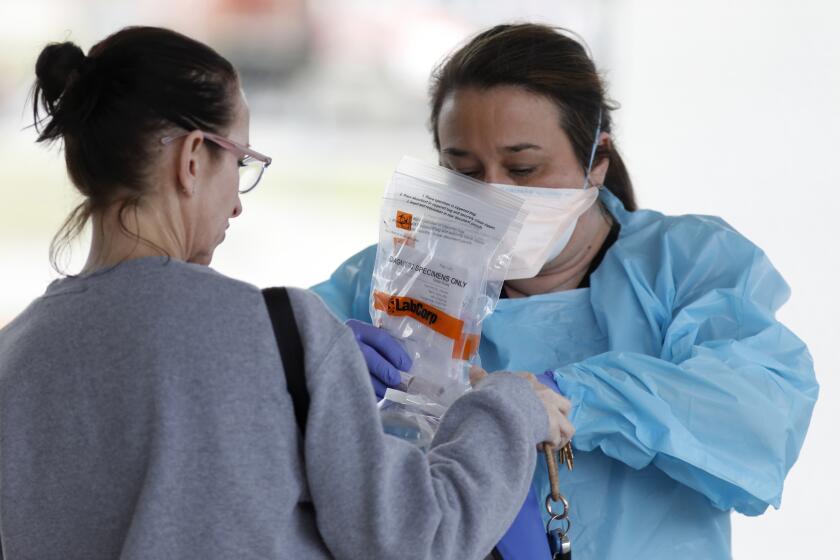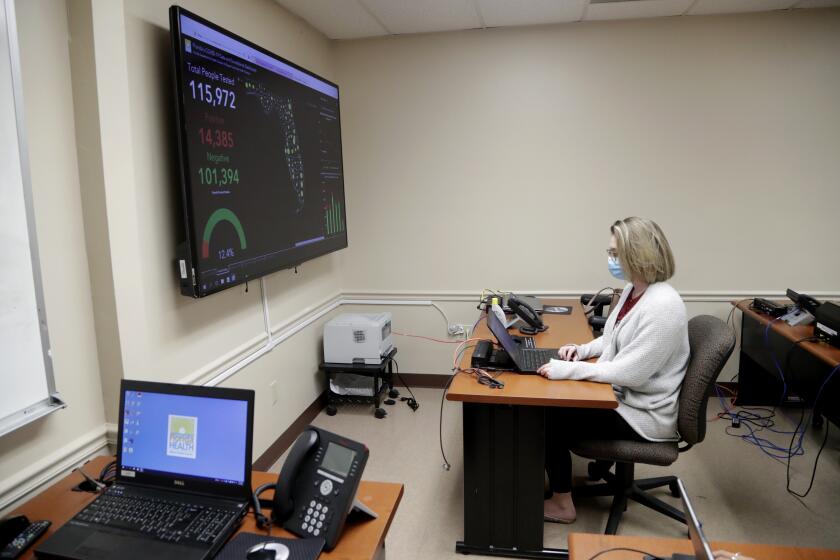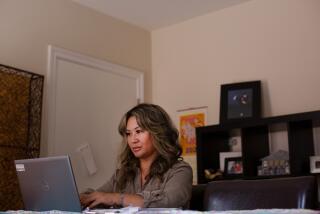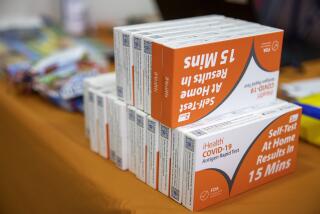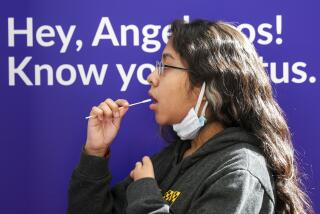The inside story of how California failed mass coronavirus testing
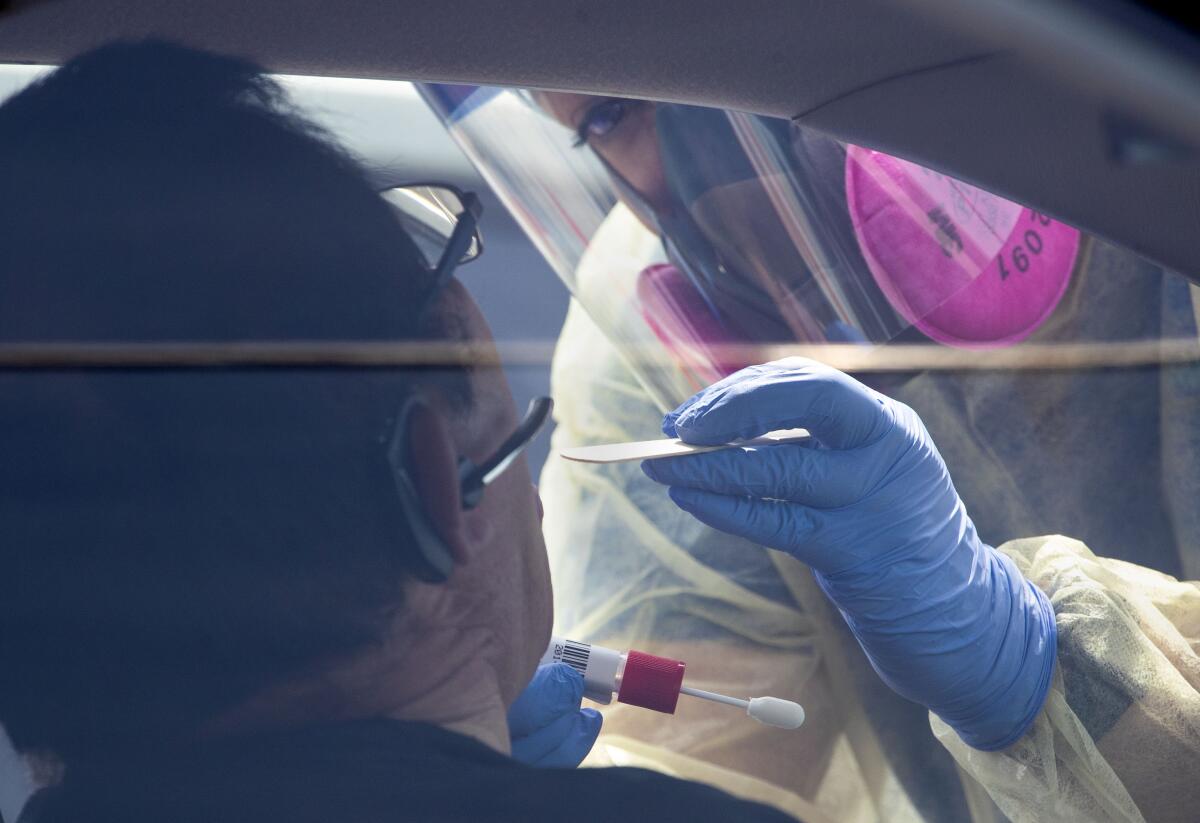
The disease investigators arrived at the apartment in street clothes, carrying their gowns, gloves and face shields in Whole Foods bags. They didn’t knock on the door.
Instead, they called the resident — a man in his 50s, then California’s first known coronavirus case — by phone. When he answered, he was instructed to move to the farthest corner of the apartment so the team could go inside and suit up.
They had come to the apartment building in Orange County to make sure the man was where he promised to be — and that he was isolating there, completely alone.
“First case. New virus. We weren’t going to take people’s word for it,” recalled the county’s medical director of communicable disease control, Dr. Matthew Zahn, who oversaw the operation.
They asked about symptoms in the patient’s wife, his child, his recent dinner guest.
So began what by many measures was the most extensive public health campaign in California: a rapid mobilization to identify people suffering from the novel coronavirus and prevent them from infecting others. In the early days, officials didn’t know whether this would be a short-term undertaking to prevent community transmission in the state or an epic battle against a once-in-a-century pandemic.
But as the latter scenario played out, California found itself unprepared, overwhelmed and constantly lagging, a Los Angeles Times investigation has found. Those early failures left California far behind in the fight against the coronavirus, and it has struggled to keep up — even as cases surge today.
In the beginning, dozens of investigators, called “cluster busters,” worked each case to try to contain the spread of the coronavirus. They aimed at identifying each strand of transmission and snipping it before the virus could take hold as a sturdy web across communities. They functioned as all-inclusive personal assistants: arranging child care, setting up WiFi, coordinating grocery drop-offs.
But data would later show that, long before the official case count began to climb, the virus was freewheeling. Federal officials grappling with a shortage of test kits issued narrow testing criteria; that meant key local spreaders in the state’s budding outbreak were going unnoticed and untraced.
The Times has now identified a third flight into LAX in which public health officials in the early stage of the COVID-19 pandemic did not alert travelers that they were at risk for infection.
Contact tracers were never alerted, for example, to people such as Margaret Cabanis-Wicht and her husband, a 41-year-old movie director in Rancho Palos Verdes who had attended a January gala in Beijing with hundreds from across China.
Twelve days after her husband’s return to California, their 5-year-old daughter woke in the night with a 102-degree fever. Cabanis-Wicht had one, too. For days, they hounded their doctors, the state health department and even the Centers for Disease Control and Prevention. But the two were ineligible for coronavirus testing because, though living with a potential carrier, they hadn’t left the country.
“We’ll never know,” Cabanis-Wicht said.
With a positive test result in the household, contact tracers would likely have visited the family, along with each of the children with whom the girl had played. Instead, Cabanis-Wicht watched in horror as school officials soon reported cases of “influenza-like illness” arising in the elementary school. In early March, a parent of a fellow student finally got a test — and turned up positive.
“Without a doubt, we were all aware that we were likely missing cases,” said Zahn, citing the testing restrictions. “We relied on test results. If you weren’t tested, we didn’t identify you.”
If the earliest potential spreaders weren’t eligible for coronavirus testing, how could cluster busters find them in time to curb a full-blown outbreak?
“It was a question we were all asking,” Zahn said.
Unprepared
The laboratory testing process relied on strikingly inefficient instruments: humans.
The strict protocol approved by federal health officials meant no automation at L.A. County’s public health lab. Lab workers hovered over patient samples, using the plastic droppers known as pipettes to manually extract genetic material from them, one by one.
They loaded samples into the wells of a testing machine that looked more like an outdated LaserJet office printer than the solution to a pandemic. It ran 18 hours a day, seven days a week. Still, by March 11, with infections likely spreading by the thousands, only about 70 people’s specimens had been tested in the Downey lab, the department’s director said.
Other counties were worse off. One in four of the state’s public health laboratories closed entirely in recent years, and there remained less than one public health lab per million state residents. Many reported an annual equipment budget of zero dollars or were under review for closure — until couriers began arriving with patient swabs and hand-scribbled test requests.
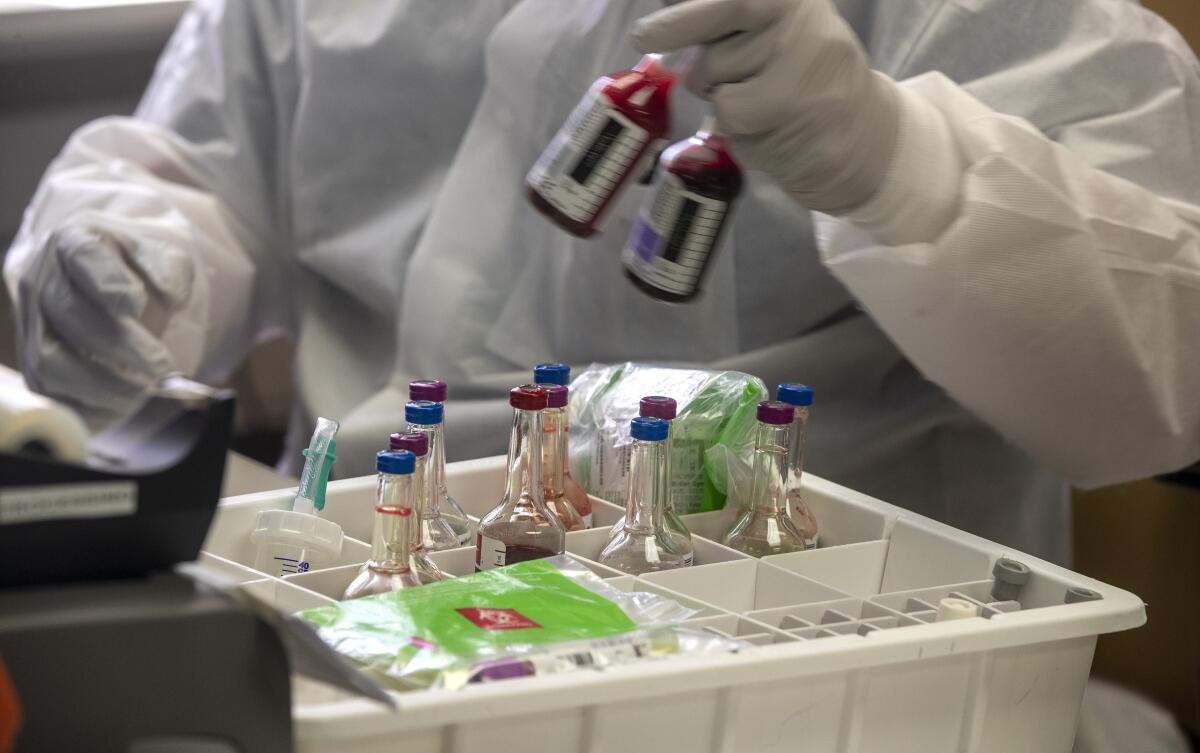
Demand for testing surged after about 1,250 Californians who had been on a cruise ship with a coronavirus patient had unknowingly scattered across the state, likely proliferating the spread. Another 9,000 people in California had recently returned from countries experiencing severe outbreaks.
The pileup of samples left the county’s testing infrastructure bottlenecked and on the brink of collapse. A county memo asked hospitals to turn away any suspected coronavirus patient with mild symptoms — without a test and without reporting the case.
“Don’t call” the public health department, one infection control coordinator wrote in an email to doctors.
The county reported a total of just 29 infections — an obvious undercount.
Outmatched
On March 13, a Friday, Steve Rusckowski, the chief executive of Quest Diagnostics, approached the podium in the Rose Garden of the White House. President Trump patted him on the back.
“Stephen,” Trump said. “Great job.”
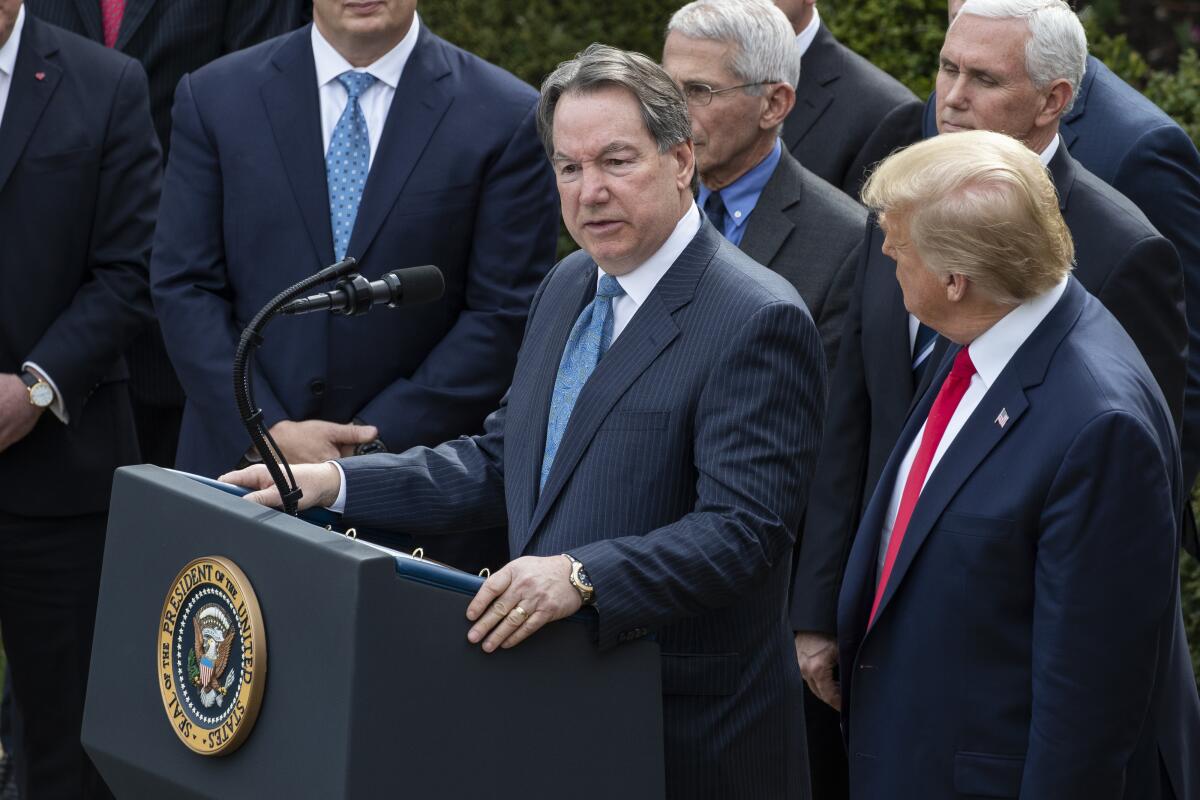
With the testing infrastructure in public facilities crippled, the federal government had turned to private partners to scale up testing. Flanked by industry leaders and members of the federal task force, Rusckowski told television cameras and print reporters that the company’s testing process was underway, adding that the number of tests available to the public “will be considerably increased in the next few weeks.”
It was. That day, Los Angeles County had reported just eight new coronavirus cases overnight; the following Friday, it reported 64 overnight. The one after that, it was 252. By the end of the month, total detection in the county surpassed 3,000 cases.
But unfortunately for Quest — and other private players such as LabCorp — the growing capacity to detect cases was only as good as supply lines. And quickly, every step in the process showed strain.
For tens of thousands of Californians to receive a coronavirus test, medical staff needed just as many cotton-tipped swabs — the “simplest piece” and yet the “No. 1” issue, said Dr. Clayton Kazan, medical director for the Los Angeles County Fire Department and former coronavirus testing coordinator for the county. A common type, called a flocked swab, is typically produced in Italy and China, where the outbreak had paralyzed manufacturing. More than 125 testing sites in California would later report swabs as their primary testing shortage.
“Failure was federal, state and local. We all failed.”
— Dr. Clayton Kazan
After collection, a swab sample was immediately inserted into a plastic screw-top tube filled with transport medium — a solution intended to preserve it on its journey. But the fluid was so scant that the U.S. Food and Drug Administration began endorsing the use of basic saline in its place.
Once it arrived at processing laboratories such as Quest or LabCorp, sample preparation required specific chemicals, known as reagents, to extract genetic material from the swab. Without the reagents, Gov. Gavin Newsom said, the test kits were “like printers, but without ink.”
But Qiagen, a top supplier, quickly fell behind. Patients in intensive care units waited more than a week for results; some nurses had to tell families that, in the pileup, the commercial labs had lost their relative’s samples entirely.
Even on their deathbeds, they had no diagnoses.
Reagent manufacturing looked like having a garden hose on hand to fight a wildfire, said Michael Osterholm, director of the Center for Infectious Disease Research and Policy at the University of Minnesota. The outbreak in Wuhan, China, demanded a full-blown fire hydrant, he added, and the global spread required “virtually a canal’s worth.”
And while states such as New York used expanded testing to screen every nursing home patient, California didn’t have the means; about half of deaths in California are from these facilities.
The testing regime “failure was federal, state and local. We all failed,” Kazan said. “If we could go back to January, when we saw what was happening in Wuhan, if we had taken that opportunity to scale ourselves up in anticipation, we could have been more prepared than we are now.”
By March 25, Quest alone had 160,000 unprocessed tests — about half of all the orders it had received.
The scramble
The backlog reached all the way to the office of Dr. Valerie Ng, the lab director at the Alameda Health System who — one day in mid-March — found herself piling patient samples into her car for a road trip to the state lab in Richmond. Two separate testing infrastructures had failed her. This was Plan C.
Earlier that month, the pileup at Quest had become insufferable; Dr. Ng had redirected samples to Alameda County’s public health lab. But their aging equipment delivered test results by fax; the head of labs at three hospitals and several clinics found herself relegated to watching for the “LOW TONER” light to illuminate on the printer.
Issues compounded when the lab equipment’s test results could not be validated. The deluge of specimens came to resemble the accelerating conveyor belt of confections in the classic chocolate factory episode of “I Love Lucy,” she said. She began chauffeuring them to Richmond.
A week after Trump promised a massive expansion of free coronavirus testing, the commercial labs tasked with the effort say they need funding to meet the rapidly rising demand.
“When the surge came, it came to the lab,” she said in an interview. “We’re swimming as fast as we can.”
Meanwhile, at UC Berkeley, molecular biologist Fyodor Urnov formed what he called “SEAL Team Six”: hand-selected scientists, physicians and students who had constructed a volunteer lab in a matter of weeks to help relieve Quest’s backlog. They “moved heaven and earth” to get government certifications and create a highly automated lab that could run as many as 1,000 patient samples a day, he said.
But when Urnov told nearby hospitals he could provide free testing and results in 48 hours, the hospitals declined, saying their electronic records systems were still entangled at Quest and LabCorp. The volunteers were stunned.
“We said, ‘What? Are you kidding me?’ They have a direct link to a testing provider that has failed,” Urnov said. “There’s institutional inertia.”
Silicon Valley steps in
Fred Turner has always been entrepreneurial. By 17, he’d built a DNA machine in his bedroom to figure out why his brother was a redhead. At 20, he dropped out of Oxford to launch his first biotech start-up. And this spring, during an afternoon kicking back at his San Francisco flat, friends of the then-24-year-old talked him into upending his life to address a new problem: coronavirus testing.
Thanks to venture capitalists, Turner, within weeks, was in a hotel room in Southern California blasting out job openings for medical technicians, lab workers and programmers. “DM if interested!” Turner, the new chief executive of the brainchild, Curative, wrote on Twitter.
Staffers slept in sleeping bags between shifts at their new facility: a former NFL/MLB anti-doping laboratory in San Dimas, its glass walls and biosafety cabinets transformed into the most efficient coronavirus testing operation in the region. By late April, patient samples stuffed inside trash bags were arriving by the truckload on the ground floor of the facility, called KorvaLabs.
Each day, some 350 employees stepped into the assembly lines: sterilizing pouches and scanning bar codes, feeding racks of samples to an automated Tecan extraction robot and transferring plates into almost two dozen viral detection machines with a “master mix” of chemicals that run in tandem almost around the clock.
Industrial engineers used digital time stamps to track the daily workflow of each step, looking for lags. “We’re back to Henry Ford,” said Dr. Jeffrey Klausner, professor of medicine and public health at UCLA, the medical director of the program.
By early May, California had gone from 2,000 to nearly 40,000 tests per day. The Curative-Korva lab was running 10,000 of them.
Back to the future
Dr. Zahn’s contact tracing team was back in action, and their caseload by late May was surging. Trading their gowns and gloves for phone lines and shared drives, tracers spend their days staring at computer screens glowing with the ever-growing lists of names.
“Don’t think Russell Crowe in ‘A Beautiful Mind.’ Don’t think Sherlock Holmes,” said Zahn. “There is no big opera music in the background. Think less glamorous: Excel spreadsheets.”
California’s contact tracers — librarians, Peace Corps volunteers and others — called infected patients and asked for the phone number of each person they’d recently seen, vowing to keep the identity of the positive case concealed. Those contacts were asked about symptoms, and they, too, were requested to isolate at home.
But the challenges were overwhelming. Los Angeles County, after a massive team scale-up, still had only 1,759 contact tracers for more than 10 million residents, and, in the U.S., there was another unique hurdle: enforcement.
As states reopen, local health departments scramble to hire enough people to trace the contacts of everyone who tests positive for the coronavirus.
Effective methods to force compliance were in use elsewhere: Taiwan monitored quarantined people with digital fencing that sounded an enforcement alarm whenever one of some 50,000 quarantined citizens ventured too far from home. Contact tracers in South Korea and Singapore kept track of infected people through GPS and Bluetooth data.
But none of those options were available in California. Contact tracers lacked authority to insist that infectious individuals avoid exposing others.
“I can’t imagine an America where we can replicate exactly what they did in Asia, given the fact that we have freedoms and a Constitution,” said Dr. Bob Kocher, a venture capital executive and former member of the governor’s task force on testing.
And the more contact tracers went about their work, the more their effectiveness was entirely dependent on the one thing they still couldn’t control: testing.
The shadow of past failures — and the legacy of ones still in the making — lingered.
For example, L.A. County health officials in early June were still only about three-quarters of the way through testing residents and staff at the nearly 400 skilled nursing facilities. In jails, another hot spot for the virus, staff have reported running out of the rapid test kits used before booking new inmates. In rural towns and inner-city neighborhoods, California is scaling back its testing expansion, citing costs.
And, in a startling déjà vu to the outbreak’s inception, L.A. County public health officials on Wednesday limited the criteria for testing due to dwindling supplies. The ever-fragile testing infrastructure is once again threatened by shortages of swabs, reagents and, curiously enough, those tiny plastic pipette tips that lab workers had wielded by hand in the Downey lab.
The droppers now work robotically, but the plastic needed to manufacture the tips is shrinking across the globe, experts say. If labs run out of the tiny, crucial components, the entire system could grind to a halt by October, they say.
“Without these little plastic tips,” Kocher said, “testing will break down again.”
Times staff writers Melody Petersen, Anita Chabria, Sandhya Kambhampati, Matt Stiles and Sean Greene contributed to this report.
More to Read
Sign up for Essential California
The most important California stories and recommendations in your inbox every morning.
You may occasionally receive promotional content from the Los Angeles Times.

